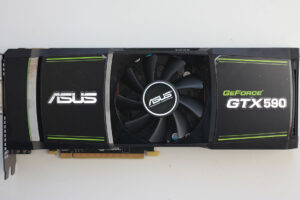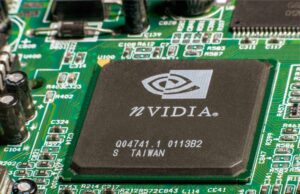The Nvidia GeForce GTX 590 saw the light of the day in early 2011. It comes across as a high-end desktop graphics card. The chief feature of this graphics card is the two GF110 chips (Fermi architecture) in SLI on a single board. Thus GeForce GTX 590 is a premium delivery from Nvidia. It meets its rival in the Radeon HD 6990. Both of them are dual-GPU video cards that are stunningly fast. This is Nvidia’s first attempt at a dual-GPU card in a long time, at least in the mad pace of competition in the graphics market. The previous one, the GeForce GTX 295, made its way into the market more than two years ago.
Indeed, it’s not easy to cram two high-end GPUs onto a dual-slot expansion card; power and thermal limitations often accompany these products. That is possibly one factor behind the absence of a dual-GPU entrant in the GeForce GTX 400 series. The first-gen chips modeled on the Fermi GPU architecture were rather late. In fact, they were thermally restricted too. Thus, they came across as uncertain candidates for the SLI-on-a-stick treatment.
The GF110 GPU in today’s high-end GeForce cards is still a rather gigantic chip. However, it’s a little easier to manage-and is a remarkable rival to the Cayman GPU in the Radeon HD 6990 series. Obviously then, Nvidia has formulated an answer to the Radeon HD 6990, one that brings about a decidedly different approach to the extreme dual graphics card.
Analyzing Gemini

Code-named “Gemini” during its developmental stages, the GTX 590 features a pair of GF110 chips onboard. Indeed, when it comes to these GPUs, none of their onboard hardware is disabled. Therefore, unit counts are identical to a pair of GeForce GTX 580 cards in SLI. Yet in order to retain the GTX 590 within a feasible power limit, Nvidia has dialed back the clock speeds to levels well below the GeForce GTX 570’s. Indeed, the GTX 590 features a core clock of just 607MHz, and the GDDR5 memory progresses steadily forwards at 854MHz – or about 3.4 GT/s. Therefore, although these are entirely enabled GF110 GPUs, the GTX 590’s projected rates for key graphic capabilities are very much identical to a pair of GeForce GTX 570s.
Theoretically, at least, the GTX 590 surpasses the Radeon HD 6990 in ROP throughput and memory bandwidth. In fact, it features two keys to fast operation at high resolutions with edge antialiasing. Indeed, Nvidia’s shader architecture is likely to be more efficient. Thus, in many cases it delivers performance comparable to AMD’s. In the meantime, the GTX 590 completely transcends the Radeon HD 6990 in peak triangle rasterization rate. Thus, this is one instance of the GF110’s rather real end-to-end excellence in geometry processing and DirectX 11 tessellation throughput.
The Card

The GTX 590 offers dual 8-pin aux power inputs to the user. Thus, it may possibly require a PSU upgrade. The card comes with a maximum power rating or TDP of 365W. Therefore, it is just 10W below the highest power that a combination of a motherboard’s PCle x16 slot and a couple of those 8-pin auxiliary inputs can deliver. The GTX 590’s expansion slot covers accomodate three dual-link DVI ports, a mini-DisplayPort connector. In fact, it also presents as much thermal venting as the card’s designers could assemble.
The GTX 590’s dual-link outputs will let it power a trio of four-megapixel monitors at once. That DisplayPort output equips the 590 to drive four displays simultaneously. Thus, the aim is productivity. The GTX 590 somehow blends the Nvidia’s best single-GPU card (the GeForce GTX 580) and the colossal Radeon HD 6990. The card also presents a centrally located fan. Dual heatsinks flank the fan. The copper bases of the heatsinks feature vapor chambers.
Also read: Logitech G432 Gaming Headset: The Detailed Review You Must Read
